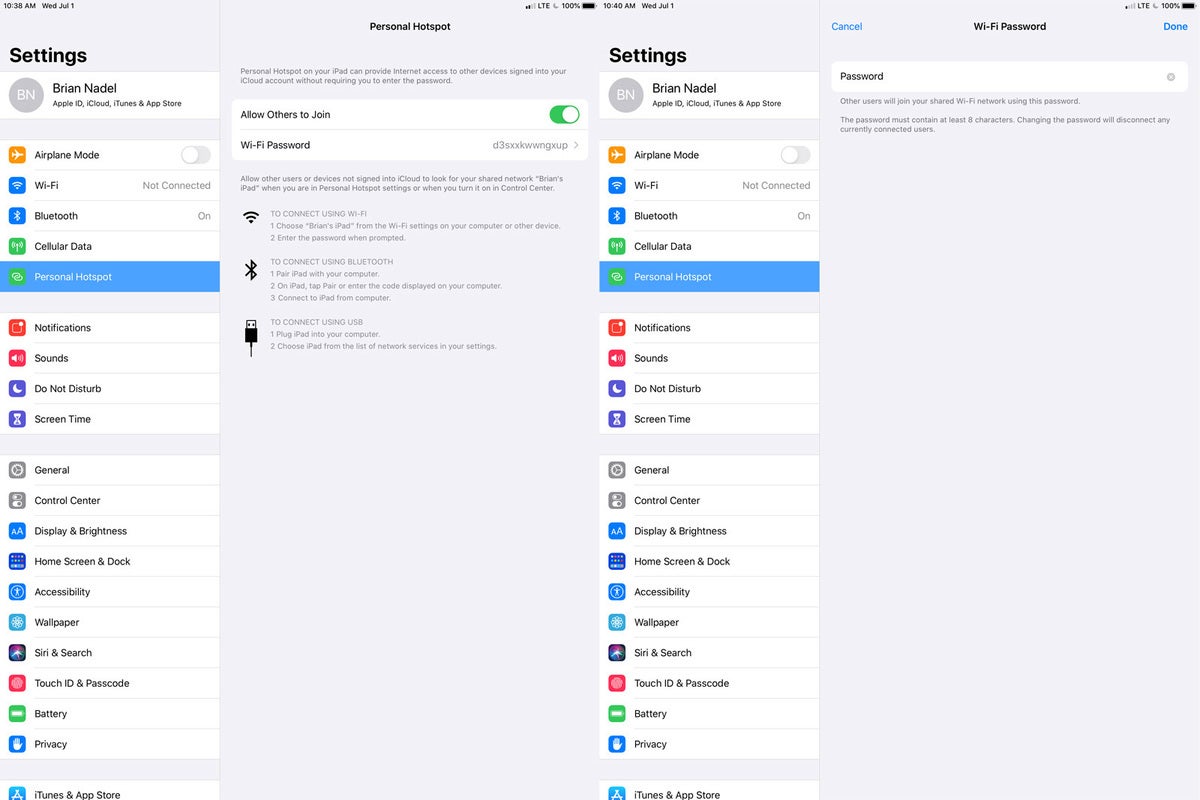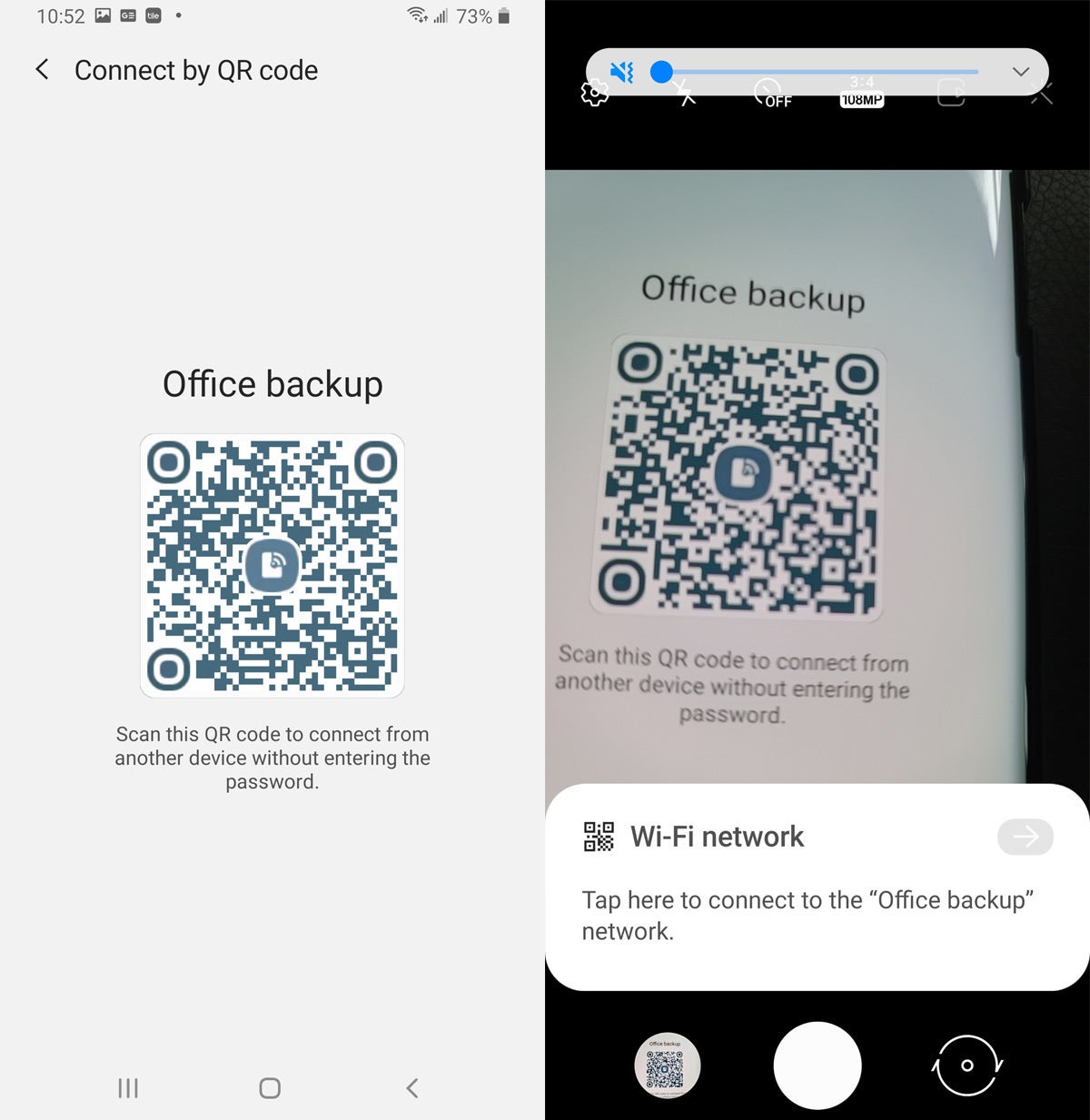Buried inside just about every smartphone is a capability that few people take advantage of but that I have come to rely on more and more: the ability to turn the phone into a Wi-Fi hotspot.
Using my phone as a hotspot (also known as Wi-Fi tethering) means that whenever I have a couple of bars of signal strength, I can get my tablet or laptop online — and share my internet connection with work colleagues. It’s my way to stay on top of work wherever I am, allowing me to read and send emails, move data back and forth with the company’s servers and even get a taste of the latest office gossip from the comfort of a full-sized device.
A phone hotspot can be a serious collaboration tool for a group of businesspeople attempting to work together. The potential ranges from a group on the way to the airport in a van finishing a group presentation to an accounting team working in a conference room with an internet connection independent of the company they’re auditing. It can also provide a connectivity lifeline for a home office when the Wi-Fi goes down.
It works just like a dedicated mobile hotspot, but because it’s inside your phone, there’s nothing extra to charge, carry, and try not to lose. When the phone is connected to the mobile data network, it can convert the data stream into a Wi-Fi signal for other devices to share. Happily, the phone can still view web sites on its screen, make calls and respond to texts while it’s hosting the hotspot connection.
This technique works with just about every current Android and iOS phone, and using your phone as a hotspot can be more secure than using a public hotspot. The usage is generally included in your monthly plan, but after you reach a specified data limit for most plans, the speed drops. On the downside, using your phone as a hotspot can chew through your phone’s battery very quickly.
After talking to representatives of phone makers and networks about their products and using my Samsung Galaxy S20 Ultra 5G as a hotspot on several field trips, I’ve updated the answers to the following 15 key questions about phone hotspotting. In a nutshell, using a hotspot can make life easier on the road, and occasionally even at home.
Mobile hotspot Q&A
1. What is a phone Wi-Fi hotspot?
At its essence, a hotspot is a blend of software, hardware and back-end network data services that combine to transform a phone into the equivalent of a broadband modem and router. In other words, it can distribute a web connection to nearby systems via Wi-Fi. This not only lets me get my laptop and tablet online, but I can share it with co-workers, as long as they’re in range and they know the password.
Some phones also allow tethering via Bluetooth and USB cables, but these techniques are less popular.
2. How does it work?
To use a phone as a hotspot, the device treats its online connection to the data network as if it were a broadband data source. It then transmits this data locally like a mini-Wi-Fi router using the 802.11ac or 802.11ax protocol with the newest handsets. The net result is that those Wi-Fi devices that are within range can tap into the data signal as if it were a regular old Wi-Fi network — because it is.
 Computerworld / IDG / Getty Images
Computerworld / IDG / Getty ImagesA phone hotspot uses a cellular network to connect to the internet, and typically shares that connection via Wi-Fi.
3. How secure is using a phone hotspot?
Using a phone hotspot can increase your security profile by letting you avoid the use of insecure public hotspots in coffee shops and hotels. At the phone end of the equation, it’s just as secure and private as making a phone call or web surfing with your phone, because 4G data traffic is generally encrypted using the Snow Stream cipher with a 128-bit encryption key.
For those able to tap into one of the emerging 5G networks, the protection is increased with 256-bit encryption; the ability to block fake mobile network transmission sites, known as stingrays; and encryption of your identity and location to thwart identity thieves. This is only the case if the network implements these defenses, though.
With any mobile network, a VPN can build a stronger wall around your communications with AES 256-bit encryption, but it often comes at the cost of performance.
Between the phone and the clients connecting through it, the phone’s hotspot uses WPA2 encryption, which requires a passcode of at least eight characters. Some newer phones from LG, Asus and Samsung can use the stronger WPA3 scheme that better protects the authentication phase of connecting.
4. Which phones can be used as hotspots?
The good news is that just about every Android or iOS phone on the market can be turned into a Wi-Fi hotspot. All it takes is a small configuration change that takes a minute at most.
Hotspot connections happen over whatever cellular networks your phone typically uses — so if your phone supports 5G and is in range of a 5G network, that’s what it will use for hotspot connections. Otherwise it will drop down to a 4G or 3G network as needed.
5G phones typically have a “5G” logo that replaces the “LTE” or “4G” one. There are a couple dozen first-generation 5G phones available, which will likely balloon in the coming years as the networks get built out and the required handset chips get cheaper and less power-hungry. The following are among the first ones out, but as you’ll see, neither Apple nor Google is represented. Expect to see 5G iPhone and Pixel handsets in the fall.
- Huawei Mate 20 X 5G
- LG V60 ThinQ 5G
- Motorola Edge Plus
- Nubia Red Magic 5G
- OnePlus 8 Pro
- Oppo Find X2 Pro
- Samsung Galaxy S20 Ultra 5G
- Vivo iQOO 3 5G
- Xiaomi Mi Mix 3 5G
- ZTE Axon 10 Pro
5. Which networks support Wi-Fi tethering?
Because it is treated like other data, all the mobile networks support the use of a phone hotspot. You’ll need to make sure your mobile plan supports it, though. Most of the business plans and many of the consumer plans from the Big Four (soon to be Big Three) national networks include hotspot use in one way or another, although the landscape might change over time with the merger of T-Mobile and Sprint.
The bad news is that while your talk-time and texting might be theoretically unlimited, the networks typically limit hotspot access to a set amount of data per month at full speed (anywhere from 3GB to 100GB, depending on your plan); after that it drops to a much slower speed.
6. How much does it cost to use a phone as a Wi-Fi hotspot?
These days hotspot use is generally included in most business and consumer plans. While you can expect these plans to change as the networks try to gain competitive advantage over each other, here’s a rundown of what each of the Big Four national networks offers at the moment.
Unless otherwise noted, prices shown below are for accounts with a single phone line. The monthly cost per line goes down as you add more lines to the account.
AT&T
Business customers have the choice of several plans, starting with the Business Unlimited Performance and Elite subscriptions that include 4G and 5G hotspot data. The Performance plan starts at $75 per month and includes 30GB of hotspot data, while the Elite plan starts at $85 per month and tops out at 100GB. There are also Mobile Share for Business plans that include 3-, 9-, 20- or 30-, 60- or 120GB of hotspot data and have monthly fees starting at $50, $60, $120, $225, $375 and $615.
By contrast, the Mobile Select and Mobile Select Priority plans let companies pool data limits, which can help with organizations where users don’t travel frequently. Pricing starts at $35 per handset, and the Priority account includes 5G data.
On the consumer side, AT&T has four plans with 4G and 5G data access for creating hotspots, starting with the $50 a month Mobile Share Plus 3GB account (with 3GB a month) and the $60 Mobile Share Plus 9GB plan (you guessed it, 9GB of data). There’s also the company’s Unlimited Extra and Elite plans for $75 and $85 per line per month that come with 15GB and 30GB of hotspot data. The Elite account can tap into AT&T’s burgeoning 5G network and comes with an HBO Max subscription to catch up on missed episodes of “Westworld.”
When you reach your monthly allotment of hotspot data, all AT&T accounts drop the bandwidth to about 128Kbps for the rest of the month.
Sprint
As part of the merger with T-Mobile, Sprint continues to operate independently but is repurposing its 2.5GHz network for use in a combined 5G system. Sprint’s consumer and business plans mirror each other in pricing and features, and the network treats 4G the same as 5G when it comes to hotspot connections.
It all starts with the Unlimited Basic plan, which allows up to 500MB of hotspot data for $60 a month. The Unlimited Plus plan costs $70 a month and includes up to 50GB of hotspot access. The top of Sprint’s pyramid is the $80 Unlimited Premium account, which offers 100GB of hotspot data.
After you hit Sprint’s data threshold for any of these plans, the hotspot data speed drops to 3G levels.
T-Mobile
The network’s Magenta for Business plan includes 3GB of hotspot data at 4G or 5G speeds depending on what’s available; after that the bandwidth drops to 3G speeds with unlimited access. Need more? T-Mobile’s PlusUp option raises the limit to 20GB for an extra $15 a month. Magenta plans start at $60 per line per month for two lines.
As far as consumer accounts go, T-Mobile’s $70 Magenta plan mirrors the Magenta business plan with 3GB of 4G or 5G data per month and unlimited 3G access. The Magenta Plus plan ups that to 20GB of 4G or 5G data and costs $85 per month. If high-speed data is not needed, T-Mobile’s Essentials plan provides unlimited use of hotspotting at 3G speeds for $60 a month.
Verizon
There are three commercial Verizon plans (Business Unlimited, Business Unlimited Plus and Business Unlimited Essential) that offer different levels of mobile hotspot speed. While the $35 per month Business Unlimited Essential plan offers unlimited use at 600Kbps, Verizon’s Business Unlimited account costs $45 a month and includes up to 10GB of 4G data for hotspotting with a $15 option for adding unlimited 5G ultra-wide band (UWB) service. Meanwhile, the Business Unlimited Plus plan provides 15GB of 4G access and unlimited UWB 5G data for $50 a month. Verizon plans to launch its low- and midrange-band 5G service later this year.
By contrast, Verizon’s consumer Play More Unlimited and Do More Unlimited plans cost $80 a month and provide 15GB of 4G and unlimited 5G UWB hotspot access. The Get More Unlimited plan is $90 a month and boosts the data limit to 30GB of 4G or 5G UWB data.
For all Verizon plans, when you reach your 4G limit, the speed drops to 600Kbps.
7. What kind of devices can connect to a phone hotspot?
A phone hotspot can work with any Wi-Fi-based device, including laptops, tablets, other phones, and even game consoles. (We don’t judge what you do in your off-hours.) Think of it as just another Wi-Fi source, only it comes from your phone.
8. How many devices can connect to a phone hotspot?
Most Android phones can connect up to 10 users at a time, while iPhones from the 4S model to the current iPhone 11 can accommodate up to five connections at once, although this might be limited to four clients by the network. Of course, the more users sharing the internet throughput, the lower the speed for each client.
9. Where can I use a hotspot?
Using a hotspot is not limited by where you are, as long as your phone is connected to your service provider’s data network. In fact, any place where you have a signal strong enough to use the web on your phone, you can generally use it as a hotspot with favorable results. I’ve used phone hotspots in my home, in my office, on trains, in hotel lobbies and in coffee shops throughout the U.S. as well as in Europe and Asia.
There’s a big bonus as well if your office’s data connection goes south. When my office’s internet connection went dead for an hour earlier this year, I used my Galaxy S20 Ultra 5G’s hotspot abilities to keep my office up and running. It wasn’t as fast as I’m used to, but it kept the emails and data exchanges flowing. The key was configuring the hotspot with the network’s name and passcode.
10. Is the setup hard to do?
Not at all. In fact, it’s one of the easiest configuration changes you can make. It’s different for iPhones and Androids but should take no more than a minute or two. A word of advice: For security purposes, be sure to change the network name and password.
For an iPhone or iPad:
- Start on the Home screen and tap the Settings icon.
- Open the Personal Hotspot section.
- Tap the slider switch to Allow Others to Join. (If you’re still using iOS 12 or earlier, the slider just says “Personal Hotspot.”)
- Instructions now appear near the middle of the screen and the network’s password near the top; the network name is the same as the name of your device.
- I suggest for security’s sake changing the password by tapping the Wi-Fi Password section and typing in a new one.
 IDG
IDGTurning on an iPad’s hotspot and changing the default password.
Because of the variety of models, providing instructions for Android phones is a little trickier. I’ve included instructions for my Galaxy S20 Ultra 5G using Android 10, but depending on its software and network, your phone might be slightly different.
- Swipe the Home screen up or down to bring up the apps and open Settings.
- Tap Connections, then scroll down and tap Mobile Hotspot and Tethering, and then tap Mobile Hotspot to enable it. Depending on your software, your menu wording might be different (such as “Wireless & networks” instead of “Connections”), and you might need to tap “More” to find the tethering and hotspot option.
- Open the Mobile Hotspot section to do everything from changing the network name and password to picking whether you want the hotspot to run on the 2.4- or 5GHz Wi-Fi network.
- If you scroll down, at the bottom you can see how many devices are connected to your hotspot network.
 IDG
IDGEnabling a hotspot on my Samsung Galaxy S20 Ultra 5G.
Once you’ve enabled the hotspot, it will be discoverable by devices scanning for Wi-Fi networks in the vicinity, but only users you’ve shared the password with can connect. Start by opening the Wi-Fi settings for your laptop or tablet and look for your new network. Then, enter the password. The system should link up in less than a minute.
Some newer Android devices offer a shortcut to hotspot connections with a QR code. To do this:
- Tap the QR code icon in the hotspot phone screen’s upper right; it now displays a QR code.
- Aim the camera of the phone or tablet you want to connect at it, and snap a photo.
- Tap to confirm you want to connect.
All told, it takes about 10 seconds to accomplish and get online.
 IDG
IDGSome newer Android devices let you scan a QR code to make the hotspot connection without a password.
Disconnecting a device from a mobile hotspot is exactly the same as with a more stationary one: either turn the Wi-Fi data exchange off or switch to another network.
Important: To prevent trailing a Wi-Fi signal wherever you go, it’s a good idea to turn the hotspot tethering off as soon as you’re done. Your battery will thank you as well.



